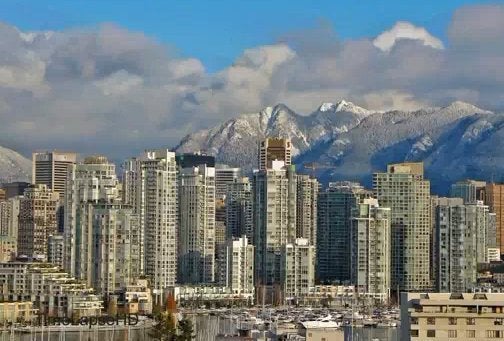
The west coast of North America may increasingly be one of the most habitable, "green", and economically vibrant regions in North America and the planet as we attempt to do a better job adapting to and mitigating the effects of climate change than we did preventing it.
The Associated Press reported on December 4, 2009, "With the world losing the battle against global warming so far, experts are warning that humans need to follow nature's example: Adapt or die."
The West Coast will play an important role in the effort to adapt.
The West Coast is projected to warm more slowly than many other parts of North America and the planet:
The West Coast may become more attractive to many people than it already is as global temperature increases unleash anticipated social unrest and mass migrations:
The UK government's chief scientist, Professor John Beddington, states that a "perfect storm" of food shortages, scarce water and insufficient energy resources threaten to unleash public unrest, cross-border conflicts and mass migration as people flee from regions worst-affected by climate change. "We head into a perfect storm in 2030, because all of these things are operating on the same time frame."
Professor Beddington's concerns were echoed by US State Department chief scientist Nina Fedoroff.
The Guardian reported on October 19, 2009 that British Prime Minister Gordon Brown "warned that the world is on the brink of a "catastrophic" future of killer heatwaves, floods and droughts...."
".... the threat was not confined to people in the developing world, Brown said."
"'The extraordinary summer heat wave of 2003 in Europe resulted in over 35,000 extra deaths. On current trends, such an event could become quite routine in Britain in just a few decades' time."
"And within the lifetime of our children and grandchildren the intense temperatures of 2003 could become the average temperature experienced throughout much of Europe. In Britain we face the prospect of more frequent droughts and a rising wave of floods."
Western-most North America, especially California, will likely remain an epicenter for developing and leveraging technology to address climate change:
According to The Clean Energy Economy: Repowering Jobs, Businesses and Investments Across America, The Pew Charitable Trusts, June 2009:
- California ranks first in all four measured categories -- Jobs, Businesses, Patents, and Venture Capital Investments. Oregon and Washington rank in the top 19 or above in all four of these categories.
"An investment of 10 trillion in renewable energy and other carbon-abatement technology will be necessary over the next two decades to limit the rise in the Earth's temperature, the International Energy Agency warns in a new report." (Wall Street Journal, 10.6.09)
A disproportionate number of the most "green" cities in the U.S. are on the west coast..
Vancouver is making progress toward its goal of becoming the greenest city in the world by 2020.
In 1975, Ernest Callenbach published Ecotopia, which, set in a 1999 future, describes an ecological utopia formed in Northern California, Oregon and Washington. Although decades later and far from resembling the green utopia Callenbach envisioned, climate change may render the western-most portions of these states and British Columbia as, at least relatively speaking, the most habitable, "green," and economically vibrant region of North America and, perhaps, the planet, over the next 90 years (if a "Climatopia" evolves on the west coast, its existence may be fleeting if the region and the world don't successfully adapt to climate change and reduce greenhouse gas emissions). The region will have many challenges to address, including: less space for people to live and work above rising sea levels; providing water, food, shelter, and energy for inhabitants; and protecting what remains of the environment that sustains human life on earth. The 2009 California Climate Adaptation Strategy (and a companion website: http://climatechange.ca.gov/) identifies climate risks (such as a sea level increase of up to 16 inches by 2050 and 55 inches by 2100, and a 35% decrease in precipitation) and adaptation options for that state. Google, in collaboration with the state, recently launched a new feature in Google Earth- CalAdapt -that displays climate change risks for California.
Albert Einstein, Groucho Marx, and other notables have observed "It's tough to make predictions, especially about the future," a point proven by successive predictions of climate change that paint increasingly grimmer pictures of our future. It is not enough to hope these predictions are wrong (or that climate change deniers are right) - we must instead heed President Kennedy's advice that "Those who plan for the future create it", and plan and create a sustainable civilization that can survive climate change. Hopefully we'll do a better job adapting to and mitigating the effects of climate change than we did preventing it.
However, our greatest challenge is not adapting to climate change (now that we have failed to prevent it); our greatest challenge is evolving our government, economic and other systems/institutions so that we can make better decisions about how to adapt to climate change than the decisions that allowed the climate crisis to get as bad as it has in the first place. Our governmental, economic, and other institutions/systems seem completely dysfunctional and unable to address any of the significant challenges we face, from nuclear proliferation to pandemics, let alone prioritize climate change as the challenge that poses the greatest threat if we don't act immediately. (For more on this, see: Humanity's Greatest Challenge).
It appears the West Coast may be one of the most interesting places on the planet as we attempt to learn to make better decisions and adapt civilization to a warming world.
Comments please!